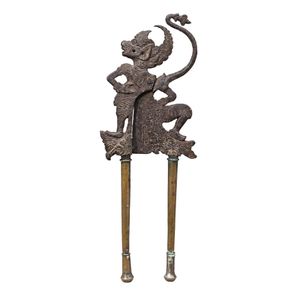Japanese Carved Jardiniere Stand with Dragon Heads and Marble Top
You must be a subscriber, and be logged in to view price and dealer details.
Subscribe Now to view actual auction price for this item
When you subscribe, you have the option of setting the currency in which to display prices to $Au, $US, $NZ or Stg.
- Baluster (furniture) - An architectural term for a column in a balustrade or staircase, often defined as a "vase shape". The shape is extensively used in furniture and decorative arts.
In furniture, it is used to describe a chair or table leg turned in that form, or more usually as an inverted baluster, with the bulbous section to the top. Less commonly used to describe a chair back that has the outline of a baluster. A baluster may also be split and applied to the front of a cupboard for ornamentation.
For ceramics and silver items it is often used to describe the shape of the whole item, rather than a part.
In Georgian glassware, the shape is commonly seen in the stem of glasses. - Serpentine - Resembling a serpent, in the form of an elongated 'S'. A serpentine front is similar to a bow front, except that the curve is shallow at each end, swelling towards the middle. The term presumably derives from its similarity to a moving snake or serpent. Serpentine fronts are usually veneered, with the carcase either being cut and shaped from a solid piece of timber, or built in the 'brick' method.
- Pierced Decoration - Ornamental woodwork with part of the background cut through and removed to produce an open-work pattern.
- Frieze - An architectural term denoting the flat, shaped or convex horizontal surface of furniture, between the architrave and the cornice, usually found on a cabinet or bookcase, or on desks and tables where it may include drawers, the area between the top and the legs. In ceramics, the term refers to the banding, of usually a repeating pattern, on the rims of plates and vases.
This item has been included into following indexes:
Visually similar items

A good Japanese rosewood vase stand, the pentagonal top inset with a red tinted marble panel raised on five ornately carved cabriole legs and with further carved and pierced cherry blossom frieze, united by a circular carved lower tier. Height 81 cm

An Anglo Ceylonese ebony and specimen wood folding table by Don Andris, circa 1850 of gate leg Sutherland form, having an acanthus carved rim to the oval top, the drop sides inlaid with radiating segment veneers of various specimen timbers, supported to ea

Bali, betel cutter (caket), iron, forged in the shape of Hanoman, 22 cm height

French Art Deco, circa 1925 sculpture of a archer with Ivorine bow unsigned after J.de Roncourt
